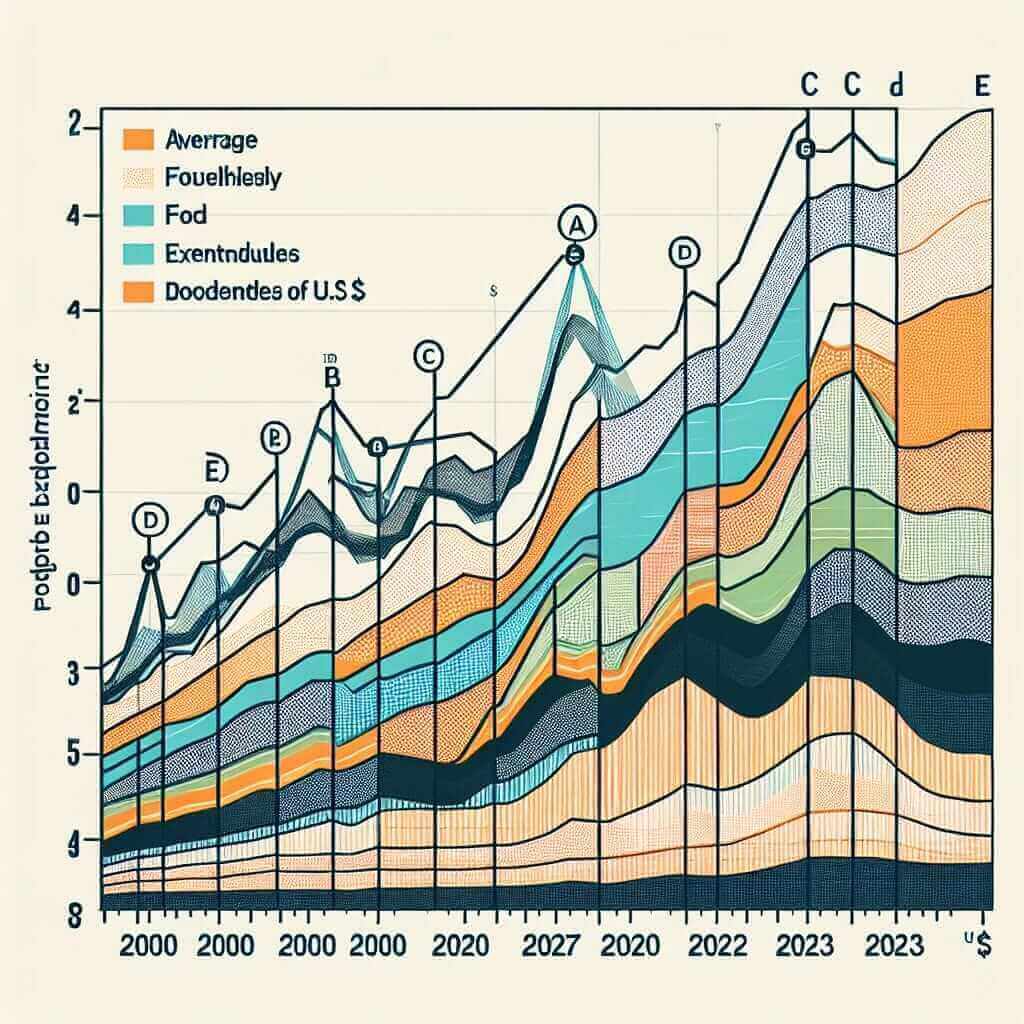In the IELTS Writing Task 1, you are often required to describe trends, make comparisons, and summarize data represented in various forms such as graphs, tables, and charts. One common topic area is consumer expenditure, and a frequently tested specific area is the average monthly expenditure on food over a period of years. This article will guide you through analyzing and presenting data on “Average Monthly Expenditure on Food (2000-2023)”.
Sample IELTS Writing Task 1 Question
Consider the following task:
You should spend about 20 minutes on this task.
The table below shows the average monthly expenditure on food by households in five countries from 2000 to 2023.
Summarize the information by selecting and reporting the main features, and make comparisons where relevant.
Write at least 150 words.
| Year | Country A | Country B | Country C | Country D | Country E |
|---|---|---|---|---|---|
| 2000 | 200 | 180 | 220 | 150 | 100 |
| 2005 | 210 | 190 | 230 | 160 | 105 |
| 2010 | 250 | 200 | 240 | 170 | 110 |
| 2015 | 260 | 210 | 250 | 180 | 115 |
| 2020 | 270 | 220 | 260 | 190 | 120 |
| 2023 | 280 | 230 | 270 | 200 | 130 |

Analyzing the Task
Step 1: Interpret the Data
The table illustrates the monthly spending on food for households in five countries (A to E) over a span of 23 years, from 2000 to 2023. Notice the gradual increase in expenditure in all countries, reflecting general trends in food prices and possibly changes in consumption habits.
Step 2: Structure Your Response
Typical IELTS Writing Task 1 responses are structured in the following way:
- Introduction: Rephrase the task statement in your own words.
- Overview: Provide a summary of the main trends and notable features.
- Details: Describe specific data points and make comparisons.
Sample Response
Introduction
The table provides information on the average monthly expenditure on food by households in five different countries between the years 2000 and 2023.
Overview
Overall, there is a clear upward trend in the average monthly expenditure on food in all five countries over the 23-year period. While Country A has consistently had the highest expenditure, Country E has had the lowest.
Body Paragraph 1
In 2000, households in Country A spent the most on food, with an average of $200 per month, followed by Country C at $220. The expenditure in Country B, Country D, and Country E were lower, at $180, $150, and $100 respectively. By 2023, these figures had increased significantly, with Country A reaching $280, Country C at $270, Country B at $230, Country D at $200, and Country E at $130.
Body Paragraph 2
Country A consistently had the highest average monthly expenditure on food throughout the period, peaking at $280 in 2023, a $80 increase from 2000. Similarly, Country C’s expenditure rose by $50, from $220 in 2000 to $270 in 2023. Country B and Country D showed more moderate increases of $50 and $50 respectively, while Country E saw the smallest rise of $30, from $100 in 2000 to $130 in 2023.
Conclusion
In summary, all five countries experienced an increase in the average monthly expenditure on food from 2000 to 2023, with the highest levels of spending observed in Country A and the lowest in Country E. This pattern suggests growing food costs and possibly changing dietary practices over the timespan.
(Word Count: 253)
Key Vocabulary and Grammar Points
Important Grammar Structures
-
Comparative Structures:
- Use comparatives to compare changes over time: “more than”, “less than”, “higher”, “lower”, etc.
- Example: “Country A’s expenditure was higher than Country B’s.”
-
Describing Trends:
- Use past simple to describe past events: “increased”, “declined”.
- Example: “The expenditure increased from 200 to 280 in Country A.”
-
Summarizing Data:
- Use expressions to summarize: “overall”, “in general”.
- Example: “Overall, there is an upward trend…”
Useful Vocabulary
-
Expenditure (n) [‘ɛkspəˈnɪʧər’]: The total amount of money that is spent on something.
- Example: “Monthly expenditure increased significantly.”
-
Trend (n) [trɛnd]: A general direction in which something is developing or changing.
- Example: “The table illustrates a rising trend.”
-
Average (adj) [‘ævərɪʤ]: The result obtained by adding several quantities together and then dividing by the number of quantities.
- Example: “The average monthly expenditure rose steadily.”
-
Significant (adj) [sɪgˈnɪfɪkənt]: Sufficiently great or important to be worthy of attention.
- Example: “There was a significant increase.”
-
Fluctuate (v) [‘flʌktʃʊˌeɪt]: Rise and fall irregularly in number or amount.
- Example: “Expenditure fluctuated before settling on an upward trend.”
By understanding these points, you will be well-prepared to craft a clear, coherent, and well-structured response to similar IELTS Writing Task 1 questions. Aim to summarize data effectively, highlight the main trends, and make relevant comparisons to achieve a band score of 7 or higher.